THE BEGINNING OF MINO KILNS
In Tounou, the southwestern area in Gifu Prefecture, the manufacture of pottery through kilns started from the early Kofun, or Tumulus, Era of the 7th century; such pottery was called Sue Ware, or Sue-ki, and were fired in underground kilns carved into mountain slopes called anagama.
Sue Ware was brought over from the Korean Peninsula in the middle of the Kofun Era; the earthenware previous to that period differed in that it was made from pottery wheels and was a very stiff pottery. Around the 6th century, there were as of yet no kilns in the entire Tounou region, so Sue Ware that had been used as burial accessories in the neighboring tumuli had to be brought over exclusively from Mino-Sue Kilns centering around Aichi Prefecture’s Sanageyou and Gifu Prefecture’s Kakamigahara.
This area’s Sue Ware was produced over the 7th and 8th centuries, and includes such products as cups, bowls, long-necked vases and kettles. The remains of Sue Ware kilns exist in around 10 cities like Tajimi, Toki, Mizunami and Kani. It is believed that this number of kilns was in response to the demands from the outlying areas. In addition, because no such remains have been discovered from the Heian Era’s 9th century, and excavations of this era’s household pottery showed that they had been solely supplied by Sanageyou, this has led to the belief that production had been stopped for a time.
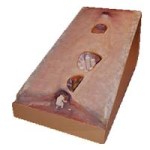
FROM SHIRASHI TO THE PRODUCTION OF YAMACHAWAN
From the Heian Era in the early 10th century, in the area including the northwestern sector of Tajimi and the western area of Kani, shirashi kilns were built. These kilns were thought to have passed through Sanageyou to Bihoku Kilns, and from the 11th-12th centuries, they even excelled over Sanageyou. Within shirashi, there are works covered in ash glaze or ones that are unglazed, and also include copies of white porcelain and celadon porcelain from the Tang and Sung Dynasties in China. Products include cups, plates, bowls, urns and vases, inkstones and bells; almost all of the goods had ash glaze brushed onto them or were soaked in it. Their usage, besides as tableware, included storageware, kitchenware and stationery, braziers and incense burners, and even ritual implements for esoteric Buddhist teachings such as rokki and kebyou. At first, the nobility, government officials, temples and shrines, and the wealthy only had access to these goods, but from the latter half of the 10th century, warriors and regular people were also able to use them. Unglazed pottery was included in the series of Sue Ware in which ritual Buddhist implements were common. Green-glazed ceramic ware doused in lead glaze was also created in the years of the 11th century. Roughly 100 kilns existed, and with the exception of Hokkaido, they were a common sight nationwide.

From the end of the Heian Era, the manufacturing of shirashi gradually began to decline along with the kinds of containers, and a conversion to the production of mainly unglazed bowls and small plates was started. This type of pottery was called yamachawan, and this phenomenon was thought to have come about from the diffusion of pottery to the masses and the beginning of pottery manufacturing on a broad national scale. The business region responsible for the manufacture of Mino kiln yamachawan excavated from historical market sites was smaller when compared to shirashi, but to increase the requests in the area, the kilns were enlarged and a conversion to mass production has been measured. The construction continued from the anagama of the previous age, and the kilns were either completely or partially underground. In addition, it was discovered that a flat zone was built on both sides of the kiln door, and remains of workshops, wood storage facilities and residential dwellings among other things have been found. The amount of wood used to enlarge the kilns increased as the areas round the kilns were deforested. The search for wood triggered a lively movement of the kilns. Then, some 20 to 30 years later when the forests replenished themselves, the kilns returned and the operations resumed. In the historic site of old kilns of Onadawakareyama in Tajimi City, there are 7 kilns in parallel formation which differs from what was the norm at that time.
In addition, from the Kamakura Era through to the Muromachi Era (13th-15th centuries), objects such as jars and urns covered in ash glaze and iron glaze and fired in Seto kilns were called Ko-Seto (Old Seto) and entered the series of pottery made over the centuries, and even a portion consisting of Ko-Seto type ceramics were also being created.
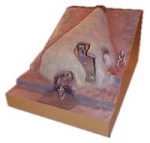
THE APPEARANCE OF LARGE KILNS AND MINO MOMOYAMA CERAMICS
At the end of the 15th century, the large kilns, whose construction differed greatly from that of the anagama up to that time, made their first appearance. The surface of the large kiln was shaped like an isosceles triangle, and the interior firing chamber had several pillars coming down from the ceiling to the floor. Compared to the anagama, the thermal efficiency was much improved in this plan. During the 130 years from the Warring States Era to the Azuchi-Momoyama Era, large kilns were used, and the types of products made around that time could be greatly differentiated. In the early period, products covered in ash glaze and iron glaze were created, but due to the popularity of tea utensils from that time onwards, teacups and tea containers copied from imported Chinese goods, as well as flowerpots were made. In addition, products covered in copper-green glaze were also created.
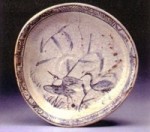
In the latter period, the pottery of the earlier period was joined by Kizeto, Setoguro and Shino in the manufacturing of the Mino Momoyama ceramics, and until the arrival of Oribe Ware in the next era, these ceramics would make for the most vivid era. Kizeto is a yellow pottery, and there were many examples that came in tanpan green and tetsusai brown. Mainly bowls and dishes as tableware, flowerpots and incense burners and containers were also made. Setoguro is a jet-black pottery whose characteristic color comes from its drawing out during kiln firing and rapid cooling. Most of Setoguro comes in the form of teacups with the earlier versions following an orthodox round shape while the latter versions had perpendicular angles and showed powerful features such as engravings on the body. Shino is a white pottery which is coated in a feldspar glaze (Shino glaze) and is represented by pottery such as tea cups, mizusashi water vessels, flowerpots, incense burners and containers, bowls, small dishes, teapots, tenmoku, tokkuri sake bottles, cups, plates and small bowls. E-Shino was the first domestic example of pottery in which a paintbrush was being truly used to paint designs.
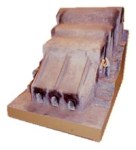
MINO KILNS OF THE EDO ERA
Around 1605, connected climbing kilns (renboushiki noborigama) which differed from the large kilns and were capable of mass production were introduced from Saga Prefecture’s Karatsu district. The firing chambers in which the pottery was baked were constructed so that they were all connected with each other. The waste heat from a lower chamber was utilized in the upper chambers so that the pottery was gradually fired in series and the thermal efficiency remarkably increased. The very first kilns for Mino Ware to be introduced were the Motoyashiki Kilns in Toki City’s Kujiri district. In these kilns, Oribe Ware was created and shaping methods of mizuhiki via the pottery wheel and stamping were jointly used. Varying shapes were made which flew against the traditional wisdom of molding techniques, and there were also many original and abstract designs. Products included teacups, plates, bowls, flowerpots, pitchers, tokkuri sake bottles, tea containers, and mizusashi water vessels, small dishes and plates, lamps for religious offerings, utensils, inkstones, waterpots, and incense burners. Later, Ofuke glazed ceramics which imitated celadon porcelain were able to be made, and included mizusashi, round bowls, plates, incense burners, tokkuri and flowerpots. Clays such as oni’ita, gosu and hakudei made their appearance as paints to color this pottery. Also, wares covered in iron and ash glazes became plentiful, and around the 18th century, this iron-glazed (ameyuu or “candy-glazed”) pottery was overwhelmingly mass-produced and was sold in the area centering around Edo. In the Houreki Era (1751-1763), ameyuu pottery was joined by jet-black glazed pottery. Furthermore, there was a change to the manufacturing of wares such as those which used both ash glaze and iron glaze, yoroide products, yanagi-e bowls and Bizen-like rust tokkuri. As well, in the large field kilns of Tajimi, excellent colored pottery was made.
In the Bunka-Bunsei Era (1804-1829), it was recorded in the literature that new wares such as dyed wares, Shirotsuchi (White Earth) Ware, Ishi (Stone) Ware, and Taihaku were started to be produced. These were thought to have been considered as porcelain goods, and when it comes to the Mino kilns, it was from this time that the production of porcelain goods was begun.
THE BEGINNING OF MASS PRODUCTION AND JOINING WORLD EXPOSITIONS
From the abolition of the systems governing kiln ownership and brewer ownership in the Meiji Era, the number of workshops and china shops grew due to the freedom in creating and selling Mino Ware. Dyed ceramic goods became commonplace, and as a gauge of the conversion to mass production, in the 15th year of the Meiji Era (1882), Yukiemon Ueda of the Wakinoshima district of Tajimi, invited pattern paper makers from the Ise-Shiroko district of Suzuka City and had them produce pattern paper so that the paper could be fit onto the surface of the porcelain. Patterns were then brushed on over the paper using gosu as a paint, and thus suri-e products were manufactured. In 1889, patterns were stenciled out using copperplate etching methods, and these were printed onto paper, and so the process of underglaze sheet copper transferring was developed for the transfer of designs. Afterwards in 1895, print sheet copper transferring, which applied the ways of underglaze sheet copper transferring, and the 1901 discovery of the nature of porous coal to absorb moisture came together to realize lithographic transfer which used the fact that water and oil repulsed each other; its usage spread.
As opposed to the development of the mass production system, Mino Ware, which showed its exquisite skill in handcraft, was presented at the popular World Expos in the West where it gained a favorable reputation. Gosuke Kato of Ichinokura, Tajimi won a bronze medal at the Paris World Expo in 1878, Enji Nishiura in the 1889 and 1900 Paris Expos won the bronze medal and gained a high reputation for himself, and exports abroad prospered.
In addition, in 1898, the Gifu Prefectural Tajimi Technical High School established the Gifu Prefecture Ceramics and Porcelain Goods Institute, (afterwards, it has been re-named a number of times up to the present day, including the Toki County Ceramic Goods Polytechnic School) a facility which was ahead of its time, and thus the development of the industry of Mino Ware was greatly boosted.
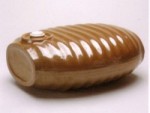
THE TWO WORLD WARS AND MINO KILNS
During World War I, which started in 1914, manufacturing in the warring nations diminished and supplies grew short. At the same time, Japan had access to the world’s markets and enjoyed a prosperous economy. Riding this economic wave, the number of producers increased and manufacturing facilities spread. In terms of the kilns, during the Taisho Era (1912-1926) the connected climbing kilns gave way to coal-burning kilns, and pottery molding was given a spur through the introduction of the electric pottery wheel. However at the end of the war, manufacturing resumed in every nation and for Japan that meant there was an excess in its own manufacturing which caused a great drop in market value and cost. In one fell swoop, Japan was in a recession which also affected the Mino Ware industry.
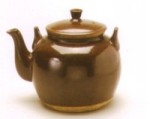
After the Manchurian Incident of 1931, and during the path toward the Sino-Japanese War, the military infrastructure had priority which meant that supplies of coal for the ceramics and porcelain industry became scarce. The industry following the coal kilns had already found itself in a major dilemma. Also, the cobalt that was indispensable for dyeing and the plaster that was needed for plaster casting had their supplies cut down to the bone. From the price regulations in place, the cost of living was frozen, and trade embargoes from the onset of the war caused many in the ceramics and porcelain industry to curtail their operations, thereby forcing those people to find other work or to stop work altogether. Furthermore, those who escaped that fate could no longer create tableware but could only follow the road that led to manufacturing of substitutes or the military industry. The government at the time collected all metal for the war effort so that the alternative industry of substituting ceramic and porcelain goods for metal goods was encouraged. The Gifu Prefecture Ceramics and Porcelain Goods Testing Center (currently known as the Gifu Prefecture Ceramics Technical Research Center) established in 1925 was directed to produce such things as prototypes.
MINO KILNS IN THE POSTWAR PERIOD
Immediately after the war, it was by choice of the war-ravaged areas to hasten the re-opening of the ceramics and porcelain industry. However, the depleted coal supplies hadn’t changed from the middle of the war, and it wasn’t easy to ensure their replenishment. Exports of ceramics and porcelain goods were re-started, and the yen depreciation against the rising American dollar meant that the circumstances were favorable in terms of the yen exchange rate, but in 1949, with the establishment of the single exchange rate of $1 US=¥360, the appreciation of the yen caused orders to plummet.
As Japan entered the 1950s, though, it was riding the tide of high economic growth, and the manufacturing of Mino Ware increased year by year with support from the progress in manufacturing technology and improvements in design. There was a transformation of coal kilns into heavy oil kilns, and tunnel kilns, fit for mass production, were introduced. And with the arrival of the oil crisis, there was a further transition to the more operable gas kilns. There was progress in the streamlining of manufacturing earth, shaping and drying, the manufactured earth was taken in by large toron mills, great amounts of ore were pulverized, and vacuum kneading machines increased the quality of the clay. Electric pottery wheels were used for shaping, Proctor dryers were used for drying, and automatic glazing machines were used for glazing. The progress of the painting processing technology increased. Under the leadership of such institutions as the Tajimi City Ceramics and Porcelain Goods Design Research Center (in 1950, it had been founded as the Painting Design Research Center), development went from lithographical printing to screen printing. Other developments involved the decoration of ceramics with characteristics such as corrosion methods, Lusterware, color staining and rubber printing methods.
The continuing good times for the ceramics and porcelain industry hit a couple of road bums due to the first dollar shock of 1971 and the oil shock of 1973 with the result of a period of low growth and stagnation, but finally from around 1983, a period of stable growth was entered. However, from the Fall of 1985, because of the yen appreciation recession, domestic demand was greatly reversed.
MINO KILNS TODAY
The long recession caused from the burst of the economic bubble, the rise in prominence of production areas of cheap ceramic and porcelain goods in countries such as China, and the change in lifestyle when it came to cuisine meant that the Mino Ware industry, which had come to focus on the mass production of small items, confronted a major crisis. To break the stranglehold of these current conditions, there has been a move towards small-scale multiproduct manufacturing in the difficult attempt to cope with cheaper foreign goods, and progress towards new fields such as the environment and nursing. Other moves involve taking a new look at product development and circulation via exchanges with other industries so that there is experimentation in the re-launch of a new Mino Ware.
On another front, there have been efforts to popularize industry tourism, an area that up to now had not been asserted by these pottery production regions. From the opening of Ceramic Park MINO as the core facility in 2002, there has been coordination amongst other facilities connected with ceramic and porcelain goods within the city such as Tajimi workshops, the Gifu Prefecture Ceramic and Porcelain Museum, the Ichinokura Sakazuki Art Gallery and the beginning of a children’s Ceramics Museum. In addition, from development of the main town and Ichinokura Oribe Street to spread the attraction of the existing historic streets and pottery studios, and the holding of the International Ceramics and Porcelain Goods Festival Mino to raise its world profile (the 11th Festival will be held in 2009), there have been great changes to the production areas in this new century to create a foundation for a history that can be proudly boasted.
>> Characteristics
>> Potter
>> Photos
>> Travel
Article and photos by Tajimi City
